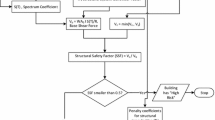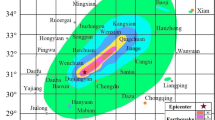Abstract
This article presents an approach to rapidly predict the seismic vulnerability existing of low-to mid-rise residential reinforced concrete (RC) buildings. In this procedure, Capacity Index is computed considering the cross-sectional orientation and size and material properties of the components of the structural system. This index is modified considering the several coefficients of possible negative impacts of structural irregularities, which are frequently found in RC buildings. Accuracy of the proposed approach has been tested considering 196 RC buildings subjected to earthquakes. The procedure categorizes the buildings either as safe or as unsafe according to whether they meet the life-safety target performance requirement. The analytical results indicate that the consistency of the proposed approach in this paper is about over 90%. Therefore, the proposed approach can be used to asses the seismic performance and vulnerability levels of existing RC buildings.





















Similar content being viewed by others
Change history
16 March 2020
This erratum is published as several corrections were overlooked during typesetting.
References
Calderon A, Silva V (2019) Probabilistic seismic vulnerability and loss assessment of the residential building stock in Costa Rica. Bull Earthq Eng 17(3):1257–1284. https://doi.org/10.1007/s10518-018-0499-1
CSI, SAP 2000 v-7.4 (2000) Integrated finite element analysis and design of structures basic analysis reference manual. Computers and Structures Inc., Berkeley
Del Gaudio C, Di Domenico M, Ricci P, Verderame GM (2018) Preliminary prediction of damage to residential buildings following the 21st August 2017 Ischia earthquake. Bull Earthq Eng 16(10):4607–4637. https://doi.org/10.1007/s10518-018-0368-y
Dilmac H, Ulutas H, Tekeli H, Demir F (2018) The investigation of seismic performance of existing RC buildings with and without infill walls. Comput Concr 22(5):439–447. https://doi.org/10.12989/cac.2018.22.5.000
Dogangun A (2003) Performance of reinforced concrete buildings during the May 1. 2003 Bingöl Earthquake in Turkey. Eng Struct 26(6):841–856. https://doi.org/10.1016/j.engstruct.2004.02.005
Federal Emergency Management Agency (FEMA) (1988) Rapid visual screening of buildings for potential seismic hazards: a handbook. FEMA 154, Washington, DC
Federal Emergency Management Agency (FEMA) (1997) NEHRP guidelines for the seismic rehabilitation of buildings. FEMA 273, Washington, DC
Federal Emergency Management Agency (FEMA) (1998) Handbook for the seismic evaluation of buildings—a prestandard. FEMA 310, Washington, DC
Federal Emergency Management Agency (FEMA) (2000) Prestandard and commentary for seismic rehabilitation of buildings. Federal Emergency Management Agency; FEMA 356, Washington, DC
Furtado A, Rodrigues H, Arêde A, Varum H, Grubišić M, Šipoš TK (2018) Prediction of the earthquake response of a three-storey infilled RC structure. Eng Struct 171:214–235. https://doi.org/10.1016/j.engstruct.2018.05.054
Gulkan P, Sozen MA (1999) Procedure for determining seismic vulnerability of building structures. ACI Struct J 96(3):336–342
Gulkan P, Yakut A (1994) An expert system for reinforced concrete structural damage quantification. In: Wight JK, Kreger ME (eds) ACI SP-162, Mete A. Sozen symposium, pp 53–71
Hassan AF, Sozen MA (1997) Seismic vulnerability assessment of low-rise buildings in regions with infrequent earthquakes. ACI Struct J 94(1):31–39
Inel M, Ozmen HB, Akyol E (2013) Observations on the building damages after 19 May 2011 Simav (Turkey) earthquake. Bull Earthq Eng 11(1):255–283. https://doi.org/10.1007/s10518-012-9414-3
Mahsuli M, Rahimi H, Bakhshi A (2019) Probabilistic seismic hazard analysis of Iran using reliability methods. Bull Earthq Eng 17(3):1117–1143. https://doi.org/10.1007/s10518-018-0498-2
MSJC (1999) Building code requirements and specification for masonry structures ACI 530 Z ASCE 5TMS 402 and ACI 530 (1999).1ASCE 6TMS 602. The Masonry Society, Boulder
Ohkubo M (1991) Current Japanese system on seismic capacity and retrofit techniques for existing reinforced concrete buildings and post-earthquake damage inspection and restoration techniques. Report no. SSRP-91/02. Department of Applied Mechanics and Engineering Sciences, University of California, San Diego
Ozmen HB, Inel M (2017) Effect of rapid screening parameters on seismic performance of RC buildings. Struct Eng Mech 62(4):391–399. https://doi.org/10.12989/sem.2017.62.4.391
Ozmen HB, Inel M, Cayci BT (2013) Engineering implications of the RC building damages after 2011 Van Earthquakes. Earthq Struct 5(3):297–319. https://doi.org/10.12989/eas.2013.5.3.297
Panagiotakos TB, Fardis MN (1996) Seismic response of infilled RC frames structures. In: 11th world conference on earthquake engineering, June, Acapulco, no. 225
Pardalopoulos S, Pantazopoulou SJ (2019) Rapid seismic assessment of two four-storey RC test buildings. Bull Earthq Eng 17(3):1379–1406. https://doi.org/10.1007/s10518-018-0500-z
Pay AC (2001) A new methodology for the seismic vulnerability assessment of existing buildings in Turkey. MS dissertation, Middle East Technical University, Graduate School of Natural and Applied Sciences, Ankara. https://hdl.handle.net/123456789/10790
Puranam AY, Irfanoglu A, Pujol S, Chiou TC, Hwang SJ (2018) Evaluation of seismic vulnerability screening indices using data from the Taiwan Earthquake of 6 February 2016. Bull Earthq Eng. https://doi.org/10.1007/s10518-018-0519-1
Rahimi H, Mahsuli M (2019) Structural reliability approach to analysis of probabilistic seismic hazard and its sensitivities. Bull Earthq Eng 17(3):1331–1359. https://doi.org/10.1007/s10518-018-0497-3
Scawthorn C, Johnson GS (2000) Preliminary report: Kocaeli (Izmit) earthquake of 17 August 1999. Eng Struct 22(7):727–745. https://doi.org/10.1016/S0141-0296(99)00106-6
Shariq M, Abbas H, Irtaza H, Qamaruddin M (2008) Influence of openings on seismic performance of masonry building walls. Build Environ 43(7):1232–1240. https://doi.org/10.1016/j.buildenv.2007.03.005
Sucuoglu H, Yazgan U (2003) Simple survey procedures for seismic risk assessment in urban building stocks. In: Wasti ST, Ozcebe G (eds) Seismic assessment and rehabilitation of existing buildings, Earth and Environmental Sciences, vol 29. Kluwer, London, pp 97–118. https://doi.org/10.1007/978-94-010-0021-5_7
Tekeli H, Dilmac H, Demir F, Gencoglu M, Guler K (2017) Shear stress indicator to predict seismic performance of residential RC buildings. Comput Concr 19(3):283–291. https://doi.org/10.12989/cac.2017.19.3.283
Turkish Standards Institute (TSE) (2000) TS 500: requirements for design and construction of reinforced concrete structures. Turkish Standards Institute, Ankara
Turkish Earthquake Code (TEC) (2007) Specifications for buildings to be built in seismic areas. Ministry of Public Works and Settlement, Ankara
Yakut A (2004) Preliminary seismic performance assessment procedure for existing RC buildings. Eng Struct 26(10):1447–1461. https://doi.org/10.1016/j.engstruct.2004.05.011
Yon B, Sayın E, Koksal TS (2013) Seismic response of buildings during the May 19, 2011 Simav, Turkey earthquake. Earthq Struct 5(3):343–357. https://doi.org/10.12989/eas.2013.5.3.343
Author information
Authors and Affiliations
Corresponding author
Additional information
Publisher’s Note
Springer Nature remains neutral with regard to jurisdictional claims in published maps and institutional affiliations.
Rights and permissions
About this article
Cite this article
Dilmaç, H. Preliminary assessment approach to predict seismic vulnerability of existing low and mid-rise RC buildings. Bull Earthquake Eng 18, 3101–3133 (2020). https://doi.org/10.1007/s10518-020-00809-z
Received:
Accepted:
Published:
Issue Date:
DOI: https://doi.org/10.1007/s10518-020-00809-z




